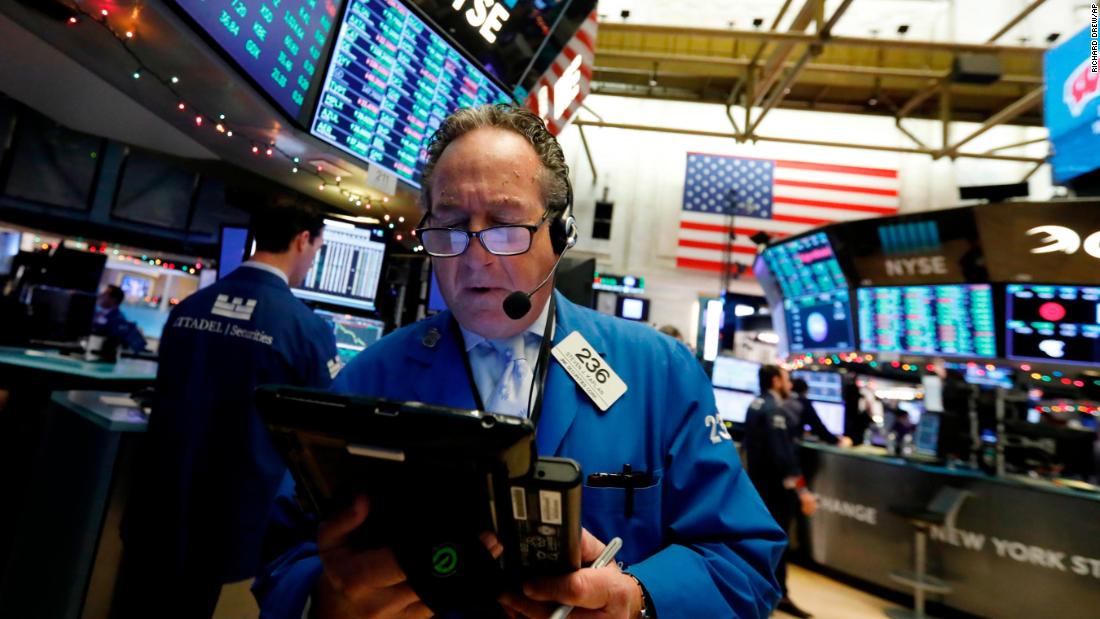
After a massive rally Wednesday, the S&P 500 is now 15.8% from its peak. If the index closes below 2,344.6, stocks will have entered a bear market.
That's 5% below where it closed Wednesday. Stocks are unlikely to enter a bear market Thursday, though stranger things have happened. The S&P 500 came within 2 points of entering bear market territory Wednesday before posting their best day in nearly 10 years.
The stock market has not fallen by 20% for 3,580 days (and counting). That is the longest period of uninterrupted stock market gains in history.
Thin trading and a lack of news could keep the bull market alive through the end of 2018, but the fears that plunged the market to its worst December since 1931 remain present. A tepid economic report in January or another worrisome statement from the Trump administration could be enough to kill the bull.
If the market does enter a bear market soon, the record books will be revised to show that the bull market actually ended on September 20, when the S&P 500 closed at a record high of 2,930. The bear market would have started the next day.
The bull and bear designations are only labels. Nothing magical happens when the stock market is up or down 20%. But they help mark broad cycles in markets and the economy. Historical evidence suggests recessions often follow the end of bull markets. That's not a guarantee, but it helps investors and businesses size up their next steps.
A remarkable run
The gains during this bull run have been eye-popping.
The S&P 500 closed at 676 on March 9, 2009, and the Dow finished that day at 6,547. Those were dark days. The global financial collapse had leveled banks. Employers were shedding jobs and unemployment was at 8.5%. There was no reason to believe a nearly-decade long bull market was starting.
Since then, stocks have gained about 250%. Including dividends, the S&P 500 has returned 327% to investors during its bull run, according to S&P Dow Jones Indices. That works out to about 16% each year over the past nine and a half years.
The bull market flirted with disaster several times over the past decade. The S&P 500 nearly fell 20% in 2011 over a debt ceiling showdown that led to the downgrade of America's credit rating. The near-collapse of the euro, China's economic slowdown and dramatic crashes in oil prices have pulled the S&P 500 lower over the years too.
But the only year the S&P 500 closed down during the bull run was in 2015 — and it fell just 0.7% that year. If the bull market lasts through the end of December, 2018 will be the second down year of the bull run — the S&P 500 is down more than 7.7% this year.
The bull market everyone hates
This bull market has been one of the most agonizing in history.
The Federal Reserve, Congress and the Obama administration goosed the economy a decade ago with stimulus, bailouts and interest rates near zero to pull the country out of a deep recession. That made borrowing cheap for years, setting off a string of record corporate profits that sent the stock market soaring.
Yet economic growth had been tepid over the past decade following the initial stimulus rush. Inflation remained stubbornly low and paychecks hardly grew at all during the bulk of the recovery.
Throughout the bull market, naysayers predicted it would end, claiming the economic data didn't support such a strong growth in the stock market.
Ironically, now that the bull appears close to its end, the economy is in the best shape of the past decade. Economic data don't support a bear market.
"We are not doomed when stocks fall 20%, and it doesn't mean the economy is inches from recession," said Chris Rupkey, managing director of MUFG. "It does make one wonder why stocks have fallen so hard and what bearish news ahead can they possibly be discounting."
What lies ahead?
The last several bear markets signaled recessions: the Great Recession of 2008, the dot-com bust of 2000 and the savings and loan crisis of the early 1990s. Is that where we're headed?
"I doubt it," said Rupkey. "I'm not panicking yet, and frankly a 20% loss means it is already to darn late to panic. As an investor, at this point, you just need to sit still and ride out the storm."
Most economists aren't predicting a recession around the corner. Unemployment remained at 3.7% in November, and the Fed expects the economy to grow 2.3% next year.
But the economic expansion, the second-longest in history, is under threat. Investors question the Federal Reserve's plans for 2019 as the pace of US economic growth is expected to slow next year.
Dysfunction in Washington isn't helping either: President Donald Trump asked aides if he could fire Fed Chairman Jerome Powell. Congress entered a budget stalemate with the president, partially shutting down the government. And trade policy that for years tried to stitch economies together is in retreat.
Bull markets don't last forever. The economic expansion was due to end at some point. But the precipitous stock market decline in December fueled by investors many fears suggests we're in for some trouble ahead.
No comments:
Post a Comment